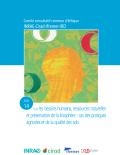Society and regional strategies Reading time 4 min
Reconciling human needs, natural resources and preservation of the biosphere
Published on 23 September 2022

Providing leads for progress
“We must sacrifice nothing: the economic relevance of our businesses and industries, their sustainability, the conflicting interests of the stakeholders involved, concern for future generations and also for the biosphere as such, its delicate balance and its own evolution [...] accept the contradictions, but aim to overcome them in the form of an innovative solution that does not deny any of the contradictory injunctions at the outset” proposed Axel Kahn in the motivations he had drafted ahead of the Committee's reflections, which began in 2019. He continued: “The aim of the Ethics Committee of our four organisations, its ambition, is to use real-life situations as a starting point to provide governments, researchers and staff with leads for progress in this context [...] A path may exist, but identifying it requires a method, and following it requires a will.
Coastal waters
To advance its reflection on coastal waters, the Ethics Committee has investigated five significant cases on the basis of interviews with scientists: competing uses of freshwater along the Charente coastline, diffuse pollution in freshwater and the sea in the Pays de la Loire region, eutrophication of coastal areas (green algae developing as a result of agricultural effluents), chlordecone pollution in banana plantations in the French West Indies, proliferation of sargassum in the Caribbean Sea.
Far from being merely scientific and technical issues, these cases of pollution and competing uses of water involve economic, societal and cultural aspects. Asymmetries of information between stakeholders, conflicts between the short and long term, and administrative red tape from the regional to the European level all need to be overcome before solutions can be proposed. The Committee invites scientists to integrate these different concerns into their reflections.

>
Download Guidance 13 pdf - 528.82 KBSoil
Using the same methodology, the Ethics Committee has gone on to address the issue of soil. According to FAO, 24 billion tonnes of fertile soil are lost every year to intensive agriculture, urbanisation and pollution. Preserving healthy soil is an issue that mobilises public policy to tackle erosion, climate change and the loss of biodiversity, as well as to ensure food security, human health and the health of ecosystems. For a long time, soil was studied as a support for production, for its physical and chemical properties. The living aspect of soil underwent a research revival in the 90s with microbiology and especially from 2010 onwards with the arrival of massive sequencing techniques to analyse its biodiversity. The roles of the biodiversity in ecological functions (such as the water cycle, nutrition, carbon storage and recycling) are increasingly being studied and recognised. The concept of ecosystem services has made it easier to understand the benefits we derive from these functions and the importance of maintaining them. By turns a source of building materials, a rubbish bin, an area to be developed, a legacy, a cultural heritage, soil is also invested with social functions. Approaches can vary greatly from one region to another, from North to South.
How can we reconcile the different instrumentalist visions of soil while preserving this common heritage? The Committee studied forest, agricultural, urban and peri-urban soils as well as dry- and wetlands, identifying a number of cross-cutting issues:
- the commons (what type of rights should be put in place to protect of rehabilitate soils)
- the benefits and limits of ecosystem services
- the need for complementary approaches at local and global levels, and interaction with local players and with policy-makers.
And a number of leads for progress: the engagement of researchers in a process of reflection based on an interest in knowledge, the need for dialogue with stakeholders, the definition of the role of the expert in public policy, the duty of researchers to inform and alert, and the invitation to pursue interdisciplinary research into soil health.

>
Guidance 14 pdf - 552.55 KB

DISCOVER THE NEW WEBSITE OF THE ETHICS IN COMMON COMMITTEEEthics in Common Committee
The Ethics in Common Committee is the new name of the Joint Consultative Ethics Committee of INRAE-Cirad-Ifremer-IRD. It explores ethical issues that may arise in research, both in France and abroad. It focuses on food, agriculture, oceans, environment and sustainable development and in particular, the relationship between science and society.
